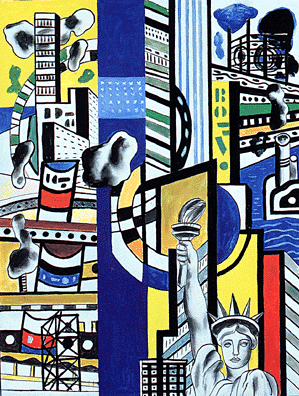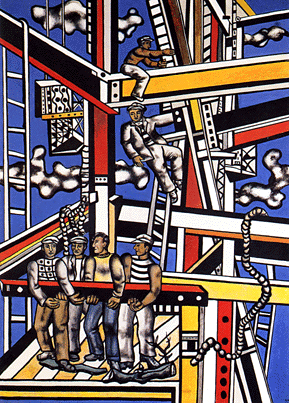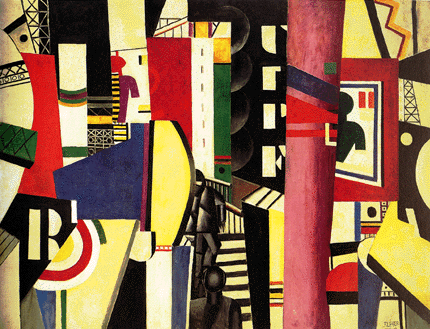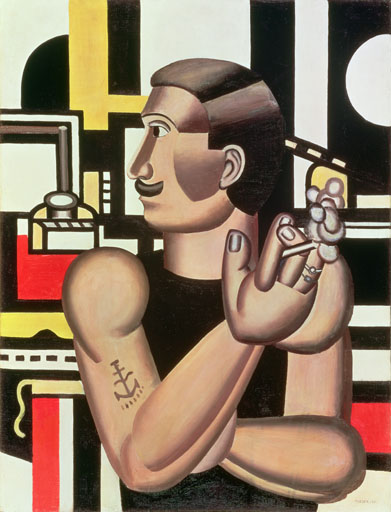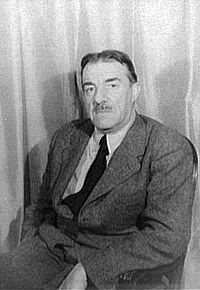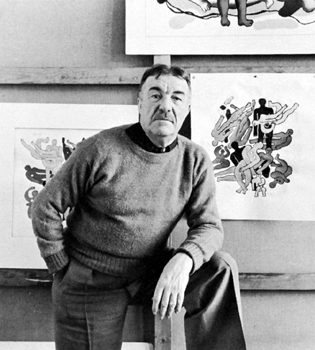<Back to Index>
- Physicist Ludwig Prandtl, 1875
- Painter Joseph Fernand Henri Léger, 1881
- General Tadeusz Kościuszko, 1746
Joseph Fernand Henri Léger (February 4, 1881 – August 17, 1955) was a French painter, sculptor, and filmmaker. In 1909 he moved to Montparnasse and met such leaders of the avant-garde as Archipenko, Lipchitz, Chagall, and Robert Delaunay. His major painting of this period is Nudes in the Forest (1909-10), in which Léger displayed a personal form of Cubism—his critics called it "Tubism" for its emphasis on cylindrical forms—that made no use of the collage technique pioneered by Braque and Picasso. In 1910 he joined with several other artists, including Delaunay, Jacques Villon, Henri Le Fauconnier, Albert Gleizes, Francis Picabia, and Marie Laurencin to form an offshoot of the Cubist movement, the Puteaux Group—also called the Section d'Or (The Golden Section). Léger was influenced during this time by Italian Futurism, and his paintings, from then until 1914, became increasingly abstract. Their vocabulary of tubular, conical, and cubed forms are laconically rendered in rough patches of primary colors plus green, black and white, as seen in the series of paintings with the title Contrasting Forms. Léger's experiences in World War I had a significant effect on his work. Mobilized in August 1914 for service in the French Army, he spent two years at the front in Argonne. He produced many sketches of artillery pieces, airplanes, and fellow soldiers while in the trenches, and painted Soldier with a Pipe (1916) while on furlough. In September 1916 he almost died after a mustard gas attack by the German troops at Verdun. During a period of convalescence in Villepinte he painted The Card Players (1917), a canvas whose robot-like, monstrous figures reflect the ambivalence of his experience of war. This
painting marked the beginning of his "mechanical period", during which
the figures and objects he created were characterized by sleekly
rendered tubular and machine-like forms. Starting in 1918, he also
produced the first paintings in the Disk series, in which disks suggestive of traffic lights figure prominently. In December 1919 he married Jeanne-Augustine Lohy, and in 1920 he met Le Corbusier, who would remain a lifelong friend. The
"mechanical" works Léger painted in the 1920s, in their formal
clarity as well as in their subject matter—the mother and child, the
female nude, figures in an ordered landscape—are typical of the postwar
"return to order" in the arts, and link him to the tradition of French
figurative painting represented by Poussin and Corot. In his paysages animés (animated
landscapes) of 1921, figures and animals exist harmoniously in
landscapes made up of streamlined forms. The frontal compositions, firm
contours, and smoothly blended colors of these paintings frequently
recall the works of Henri Rousseau, an artist Léger greatly admired and whom he had met in 1909. They also share traits with the work of Le Corbusier and Amédée Ozenfant who together had founded Purism,
a style intended as a rational, mathematically based corrective to the
impulsiveness of cubism. Combining the classical with the modern,
Léger's Nude on a Red Background (1927)
depicts a monumental, expressionless woman, machine-like in form and
color. His still life compositions from this period are dominated by
stable, interlocking rectangular formations in vertical and horizontal
orientation. The Siphon of
1924, a still life based on an advertisement in the popular press for
the aperitif Campari, represents the high-water mark of the Purist
aesthetic in Léger's work. As an enthusiast of the modern, Léger was greatly attracted to cinema, and for a time he considered giving up painting for filmmaking. In 1923-24 he designed the set for the laboratory scene in Marcel L'Herbier's L'Inhumaine (The Inhuman One). In 1924, in collaboration with Dudley Murphy, George Antheil, and Man Ray, Léger produced and directed the iconic and Futurism-influenced film, Ballet Mécanique (Mechanical
Ballet). Neither abstract nor narrative, it is a series of images of a
woman's lips and teeth, close-up shots of ordinary objects, and
repeated images of human activities and machines in rhythmic movement. In collaboration with Amédée Ozenfant he established a free school where he taught from 1924, with Alexandra Exter and
Marie Laurencin. He produced the first of his "mural paintings",
influenced by Le Corbusier's theories, in 1925. Intended to be
incorporated into polychrome architecture, they are among his most
abstract paintings, featuring flat areas of color that appear to
advance or recede. Starting
in 1927, the character of Léger's work gradually changed as
organic and irregular forms assumed greater importance. The figural style that emerged in the 1930s is fully displayed in the Two Sisters of 1935, and in several versions of Adam and Eve. With characteristic humor, he portrayed Adam in a striped bathing suit, or sporting a tattoo. In 1931, Leger visited New York City and decorated Nelson Rockefeller's apartment. In 1935, the Museum of Modern Art in New York City presented an exhibition of his work. During World War II Léger
lived in the United States, where he found inspiration in the novel
sight of industrial refuse in the landscape. The shock of juxtaposed
natural forms and mechanical elements, the "tons of abandoned machines
with flowers cropping up from within, and birds perching on top of
them" exemplified what he called the "law of contrast". His enthusiasm for such contrasts resulted in such works as The Tree in the Ladder of 1943-44, and Romantic Landscape of 1946. A major work of 1944, Three Musicians (Museum
of Modern Art, New York), reprises a composition of 1930. A folk-like
composition reminiscent of Rousseau, it exploits the law of contrasts
in its realistic juxtaposition of the three men and their instruments. Upon his return to France in 1945, he joined the Communist Party.
During this period his work became less abstract, and he produced many
monumental figure compositions depicting scenes of popular life
featuring acrobats, builders, divers, and country outings. His
varied projects included book illustrations, murals, stained-glass
windows, mosaics, polychrome ceramic sculptures, and set and costume
designs. After the death of his wife in 1950, Léger married Nadia Khodossevitch in 1952. In his final years he lectured in Bern, designed mosaics and stained-glass windows for the Central University of Venezuela in Caracas, Venezuela, and painted Country Outing, The Camper, and the series The Big Parade. In 1954 he began a project for a mosaic for the São Paulo Opera, which he would not live to finish. Fernand Léger died at his home in 1955 and is buried in Gif-sur-Yvette, Essonne.
Léger was born in the Argentan, Orne, Basse-Normandie, where his father raised cattle. Fernand Léger initially trained as an architect from 1897-1899 before moving in 1900 to Paris, where he supported himself as an architectural draftsman. After military service in Versailles in 1902-1903, he enrolled at the School of Decorative Arts; he also applied to the Ecole des Beaux-Arts but
was rejected. He nevertheless attended the Beaux-Arts as a non-enrolled
student, spending what he described as "three empty and useless years"
studying with Gérôme and others, while also studying at the Académie Julian. He began to work seriously as a painter only at the age of 25. At this point his work showed the influence of Impressionism, as seen in Le Jardin de ma mère (My
Mother's Garden) of 1905, one of the few paintings from this period
that he did not later destroy. A new emphasis on drawing and geometry
appeared in Léger's work after he saw the Cézanne retrospective at the Salon d'Automne in 1907.
